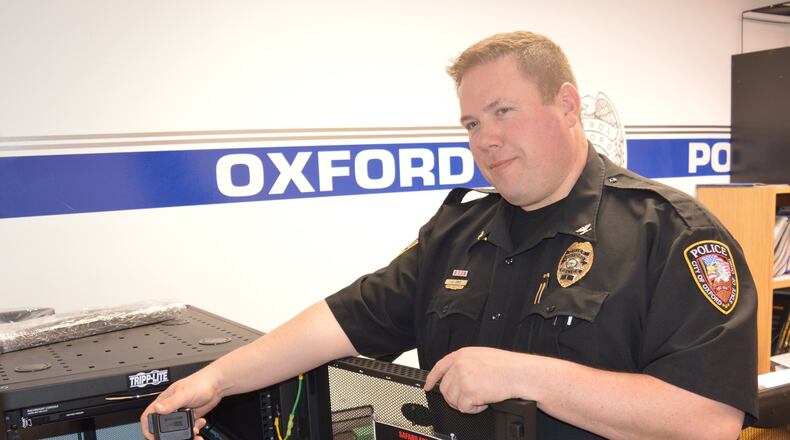The policy does mean extra training and work for the officers and Chief John Jones emphasized those recordings do not take the place of written reports already required.
“They do not replace reports,” the chief said. “They are useful in tense use-of-force situations. I think they are valuable in dealing with minor complaints.”
MORE POPULAR STORIES
Area fire departments are hiring full-timers in bunches. Here’s why.
Prosecutor: Middletown bar death could be classic case of ‘one-punch homicide’
Body worn cameras have become more prominent in recent years in the wake of accusations of police mistreatment of civilians but chief Jones said they work both ways. In the case of an accusation against a police officer, they can provide a look at the actual events and in the case of an arrest, they can provide further evidence of the offense.
“As body worn cameras started being more popular among agencies, we have seen more vendors marketing their BWCs,” the chief said, noting many e-mails had been coming to his office from vendors, who were becoming increasingly visible at police-related conferences. “We tested at least three major brands and demoed different types of cameras within those vendors.”
City Council last July approved a three-year contract at a cost of $36,092.99 with Safariland VIEVU which covers purchase of 27 body worn cameras, docking station, storage and management software. Included in the purchase was a multi-unit docking station for data download, unlimited data storage for 370 days, and an online video management software solution. In a staff report at the time, Jones outlined three options—$20, $30 and $50 per unit—with the difference being the length of time videos would be stored.
This plan allows for storage for a year. It also allows for storage beyond that time for videos still needed for evidence in pending cases, he explained recently.
“We thought these were the most simplistic, straight-forward model,” Jones said, acknowledging younger officers have an easier time adjusting to their use since their training may have included use of cameras and they may have more experience with technology, in general. The more veteran officers need to adapt to them and build their use into “muscle memory” of routine actions at the beginning of an interaction with the public.
Police Community Relations and Review Commission members received a report and explanation of the cameras’ use at their Feb. 15 meeting and Jones said there were few comments or questions.
The cameras went into regular use by patrol officer in January after the department’s procedural order was issued Jan. 16 and officers received training in their use.
That policy was written using a standard policy from the Ohio Collaborative which included input from the American Civil Liberties Union and the International Association of Police Chiefs.
“The ACLU originally wanted (cameras) used, but then had concerns about privacy issues,” Jones said. “We look for it to better our transparency with the public and also for better reports, to document transactions between the public and officers.”
Those privacy concerns are addressed in the policy, the chief noted.
“The policy is written so that in a public location the cameras keep rolling. In private locations, such as a home, the officer will inform the person they are being recorded. If they request the camera be turned off, we will honor that,” Jones said, explaining there are exceptions. “There is still a lot of gray. We will use them if it is a domestic violence call. We will do our best in the public records realm to protect privacy.”
The policy requires the camera to operate to capture the request to turn it off before it is deactivated. Since the cameras capture audio as well as visual, the system does allow for “redacting” both in the case of a privacy concern, such as a face being blurred or a social security number being bleeped.
The policy also requires officers to download and document videos with report numbers so they can be easily matched to their paper equivalents.
Officer Julia Huff said one easy way to do that is to speak that call information into the camera when it is activated at arrival to a scene.
She said officers have learned to download their videos at various times during a shift when they visit the police station, rather than doing all of them at one time at the end of a shift.
BWCs are stored in a cabinet in the squad room in a tray which serves as both a charging station and computer link for the videos to be downloaded and identified.
Jones said the cameras do have some limitations, such as in low light areas or situations where an officer is in close proximity to someone such as in a struggle. Another, more serious, limitation he explained is the camera’s inability to capture physical cues an officer is trained to detect, such as a flinch or, for example, grabbing onto an arm from the side.
“It’s important for the public there should not be a rush to condemn an officer based on the BWC. The camera does not pick up danger cues an officer can detect. There are a lot of limitations and a lot of them we have not thought of yet,” the chief said. “It’s a new tool officers need to get used to. Some trepidation is natural but we need to look to better document these contacts and better capture what happened.”
About the Author
